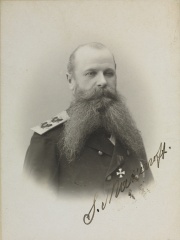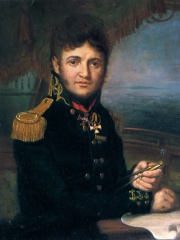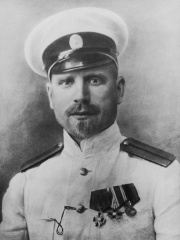


The Most Famous
EXPLORERS from Ukraine
Top 3
The following people are considered by Pantheon to be the most legendary Ukrainian Explorers of all time. This list of famous Ukrainian Explorers is sorted by HPI (Historical Popularity Index), a metric that aggregates information on a biography's online popularity.

1. Stepan Makarov (1848 - 1904)
With an HPI of 68.96, Stepan Makarov is the most famous Ukrainian Explorer. His biography has been translated into 35 different languages on wikipedia.
Stepan Osipovich Makarov (Russian: Степан Осипович Макаров, Ukrainian: Степан Осипович Макаров; 8 January 1849 [O.S. 27 December 1848] – 13 April [O.S. 31 March] 1904) was a Russian vice-admiral, commander in the Imperial Russian Navy, oceanographer, member of the Russian Academy of Sciences, and author of several books. He was a pioneer of insubmersibility theory (the concept of counter-flooding to stabilise a damaged ship), and developer of a Cyrillic-based semaphore alphabet. A proponent of icebreaker use, he supervised the first polar icebreaker construction. Makarov also designed several ships. Makarov saw service in the Russo-Turkish War (1877–1878) as a captain, and ordered the first successful attack with a self propelled torpedo. He served again in the Russo-Japanese War as vice-admiral and was assigned to the defense of Port Arthur, where he was hailed as a competent and aggressive commander. On 13 April 1904 Makarov led his flotilla to the aid of a destroyer that had been ambushed by the Japanese. Makarov was killed in the subsequent battle when his flagship Petropavlovsk struck a naval mine and the ship's magazine detonated. Japanese divers found Makarov's body after the war and gave him a burial at sea, and as a mark of good will Japanese officers led Makarov's funeral in Port Arthur. In 1946, after the Soviet invasion of South Sakhalin, the village of Shiritoru on that island was forcibly depopulated of its Japanese inhabitants and renamed Makarov in his honor.

2. Yuri Lisyansky (1773 - 1837)
With an HPI of 58.35, Yuri Lisyansky is the 2nd most famous Ukrainian Explorer. His biography has been translated into 25 different languages.
Yuri Fyodorovich Lisyansky (Ukrainian: Юрій Федорович Лисянський, romanized: Yuri Fedorovych Lysianskyi; Russian: Юрий Фёдорович Лисянский; 12 April [O.S. 1 April] 1773 – 6 March 1837) was an explorer and officer in the Imperial Russian Navy. He served as a volunteer in the British Royal Navy and later headed the first Russian circumnavigation aboard the Neva. He was also among the early western explorers to visit Easter Island.

3. Georgy Sedov (1877 - 1914)
With an HPI of 56.78, Georgy Sedov is the 3rd most famous Ukrainian Explorer. His biography has been translated into 23 different languages.
Georgy Yakovlevich Sedov (Russian: Гео́ргий Я́ковлевич Седо́в; 5 May [O.S. 23 April] 1877 – 5 March [O.S. 20 February] 1914) was a Russian Arctic explorer. Sedov was born in the village of Krivaya Kosa of Taganrog district (now Novoazovskyi Raion, Donetsk Oblast) to a fisherman's family. In 1898, he finished navigation courses in Rostov-on-Don and acquired the rank of long voyage navigator. In 1901, he took an external degree at a naval college, passed all the exams, and was promoted to the rank of lieutenant. From 1902 to 1903, Sedov participated in a hydrographic expedition in the Arctic Ocean. In 1905, during the Russo-Japanese War, he was in charge of a torpedo boat. In 1909, he led the expedition that would later describe the mouth of the Kolyma River. The following year, Sedov explored the Krestovaya Bay on Novaya Zemlya. In 1912, he proposed a sleigh expedition for reaching the North Pole. The Tsarist government refused to finance this project and the expedition was organized with help from independent sources. On August 14 (27), 1912, Sedov's ship Svyatoy Muchenik Foka (Saint Phocas the Martyr) left Arkhangelsk and had to stay for the winter near Novaya Zemlya because of impassable ice. The expedition reached Franz Josef Land only in August 1913; however, it had to stay for the second winter in the Tikhaya Bay due to lack of coal. On February 2 (15), 1914, Sedov (already sick with scurvy) and his accompanying seamen G. Linnik and A. Pustotniy set off for the North Pole with their draft dogs. Before reaching Rudolf Island, Sedov died at sea and was buried at Cape Auk on the island. On the way back, at Franz Josef Land, the Svyatoy Foka rescued two survivors of the Brusilov expedition, including Valerian Albanov. As part of the search for the Sedov expedition, Jan Nagórski made the first airplane flights over the Arctic, gaining valuable experience for later aeronautical expeditions to the region. Two gulfs and a peak on Novaya Zemlya, a glacier and a cape on Franz Josef Land, an island in the Barents Sea, and a cape in Antarctica bear Sedov's name. There was also a steam icebreaker Georgy Sedov. Today, the sail training barque STS Sedov bears his name.
People
Pantheon has 3 people classified as Ukrainian explorers born between 1773 and 1877. Of these 3, none of them are still alive today. The most famous deceased Ukrainian explorers include Stepan Makarov, Yuri Lisyansky, and Georgy Sedov.
Deceased Ukrainian Explorers
Go to all RankingsStepan Makarov
1848 - 1904
HPI: 68.96
Yuri Lisyansky
1773 - 1837
HPI: 58.35
Georgy Sedov
1877 - 1914
HPI: 56.78
Overlapping Lives
Which Explorers were alive at the same time? This visualization shows the lifespans of the 3 most globally memorable Explorers since 1700.

